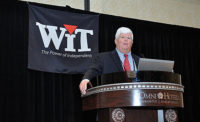Changing with the times in PHCP-PVF buying groups, Part 1
Supply House Times spoke with representatives of eight PHCP-PVF buying groups about a variety of topics.

From left, Embassy Group’s Maureen Cosyns, Mike Lepley and Shari Kelly outside company headquarters in Geneva, Ill. In recent times Embassy has added product categories, including a growing waterworks division several years ago. Photo by Mike Miazga/Supply House Times

Luxury Products Group’s Linda Hoff and Omni’s Bob Hoff say both buying groups have been active in developing new programs to help members. Photo by Mike Miazga/Supply House Times

The Forte decorative plumbing and hardware buying group is better helping its shareholders through a variety of educational tools. Photo by Mike Miazga/Supply House Times



Embassy Group President Mike Lepley doesn’t mince words when he talks about the main function of his Geneva, Ill.-based buying group.
“We don’t ever forget the purpose of being together and that is the financial returns to our shareholders,” he says. “We never take our eye off that and we’ll never change. The goal is to return as much shareholder value as possible.”
Lepley’s view is mirrored by his counterparts throughout the industry — buying groups ultimately are in existence to help members maximize purchasing power and ultimately the best financial returns possible.
But in an era where change and challenge is constant, buying groups have taken to the offensive in providing their members innovative programs and services that go well beyond simple rebates and are aimed to take their members’ businesses to the next level in today’s competitive marketplace.
“Most people would say buying groups came together in order to collectively purchase better and share best practices so they could effectively compete against national chains,” WIT Executive Vice President/COO Charlie Moorhead says. “While that still is a critical part of what we do today, I think the more progressive groups have evolved well beyond that point. The groups today are much more involved with their distributors than they were in the early days.”
Supply House Times spoke with representatives of eight PHCP-PVF buying groups about a variety of topics, including the evolution of the buying group, consolidation and the new services and programs they are providing their members. Part 2 appears in the August issue of the magazine.
Lepley says it’s critical to listen and be responsive to the needs of the buying group membership. “We try to adapt to the changes in the marketplace,” he said. “Our board of directors and various committees are very engaged and responsive — one huge advantage of a member-owned group. At the end of the day we are here to facilitate the needs of our members and our vendor partners.”
Omni Corporate Services President Bob Hoff stresses it’s important to keep in mind no two distributors operate their businesses exactly alike. “Wholesalers are not the same,” he says. “Everybody approaches the market differently. If someone can make more selling central vacuum systems, they will go after it.”
Equity Plumbing Vice President of Marketing Ted Havel adds: “We must be conscious of the current challenges and opportunities independent wholesalers are facing. As we expand our role it will be necessary to develop innovative resources that assist the membership in tackling these challenges and opportunities.”
Winning strategies
Buying group executives provided a plethora of examples when asked what types of programs and services they have rolled out to best help their memberships.
Havel says Equity, which features a large roster of mid-smaller distributors throughout the country, is using enhanced marketing tools to benefit its members. “Our focus will be on providing members with cost-effective marketing solutions that aid in retaining valued customers as a generational shift to online business grows each year,” he says. “In addition, we will be providing resources to help our members attract and retain quality local sales personnel which has been the key to not only surviving but thriving in spite of the latest competitive threat.”
Specifically, Equity has rolled out its Gold/Platinum program that acknowledges and rewards members that achieve growth with Equity suppliers and participate fully and effectively in Equity marketing resources. The group’s GainShare joint market planning program is tailored to drive sales and increase profitability for both members and suppliers.
Omni also has been active in developing programs for its members. To help with health-care costs, the Ohio-based group started an insurance captive called Member Advantage Healthcare Program.
“With the cost of health-care insurance rising dramatically we decided to take steps to look at this and leverage group purchasing power with health care,” says Hoff, who adds he’s open to offering the captive to non-Omni members and manufacturers. “Those who have joined have been very pleased and it’s continuing to grow exponentially.”
The other major Omni rollout is its Fill It Now website that virtually links member warehouses together, providing the 250-some Omni members access to a massive network of product availability. “That’s roughly 500 to 600 locations throughout the U.S.,” Hoff points out. “You take everything inventoried and you have one tremendous warehouse. Every one of our members can find darned near anything. It’s a vehicle for our members that especially comes into play on the showroom side where there are so many different styles and changes.”
WIT’s advancements with its members are multifold. “We interact with our distributors and vendor partners in all aspects of their business — training and education, accounting, marketing, purchasing, new products and technology initiatives,” Moorhead says.
But it’s technology where the Irving, Texas-based group is really honing in on. “We’re more involved in looking at all the opportunities afforded us in the area of technology,” Moorhead notes. “Our business model is a little different than some of the other groups and WIT is seeking ways to provide better ‘connectivity’ to our suppliers and distributors. We’re also looking at ways to provide more accurate and timely market-share information to our suppliers.”
Affiliated Distributors PHCP Division President Jeffrey Beall says ramping up internal communications with its members is of critical importance in today’s digital age.
“Technology is bringing the greatest change to our industry with great speed,” he says. “We want our members to see their performance quicker and react with increased timeliness. Our reporting is focused on areas where we have continued opportunity to provide a company’s accounting department and CFO and their purchasing department with the data they need. We’ve improved those processes and that’s been a key win for our members and suppliers.”
On the luxury/decorative side, Luxury Products Group, comprised of Omni members that also operate showrooms, has introduced Spec Book, a vehicle for showroom salespeople that acts much like a baby shower/bridal registry. “A customer can say I want this, this and this and we can print out a book with photos of all the products with specs so they can give it to the builder,” LPG Executive Director Linda Hoff says.
Additionally, LPG has contracted with Web design companies that specialize in working with showrooms. “We are helping our showroom people get that ‘wow’ website,” Hoff says.
Forte is better helping its shareholders through a variety of educational tools, including a sales conference developed specifically for the decorative plumbing and hardware showroom, internal electronic communications such as a weekly product and trends report, a monthly online magazine and an e-blast targeted to shareholder principals.
“Our principal-directed e-blasts have better than a 90 percent open rate,” Forte Executive Director Tom Cohn says. “When our principals see that come through, they know it’s a bottom-line-affecting announcement. It takes a lot of effort and intellectual capital to produce what we do, but those communications are helping take us to the next level as a group.”
Forte also has introduced controlled distribution of product through its private label line, exclusive distribution agreements and product-only agreements through different manufacturers.
The Delta Distributors buying group, comprised of 19 industrial PVF distributors, continues to focus on its main staples of the transparency of its LLC partnership, direct relationships with vendors and holding steadfast to its rule of not having two member headquarters locations in the same region. “We don’t believe in having two aircraft carriers in the same waters,” Delta President Phil Knipper says.
Welcome to the family
Just as distributors have done in recent times, buying groups in the PHCP-PVF space are embracing the idea of diversification. Linda Hoff notes Luxury Products Group is looking for ways to add complementary product categories related to the luxury bath and kitchen presentation. “Before it may have been granite or china sinks and now it’s bamboo sinks or stone and marble products,” she says. “We have our base of products and now are filling in with different products. We’re going outside the actual plumbing industry. We are looking at ways to incorporate other manufacturers that might not be plumbing products.”
Embassy, which celebrates its 25th anniversary next year, previously branched out into HVAC where it now has 38 members and 65 vendors participating in that space and recently added a highly successful waterworks vertical (19 members and 25 vendors).
“We spend a great deal of time and investment within our verticals,” Lepley says. “Many of our members compete in different segments so we are able to give our membership more options and thus more financial returns.”
Affiliated Distributors continues to add verticals (bearings and power transmission is the latest), as well as geographic footprint. “We’re investing in technology, new programs, new markets and industries,” Beall says. “We’ve very passionate about growing our business across multiple industries and continents for our members and suppliers.”
Delta’s Knipper says all the advancements buying groups are making are done with one end result in mind. “In short, there is no nuclear fusion involved in buying groups,” he says. “We perform functions that are advantageous to independent wholesalers.”
In Part 2 next month, buying group leaders discuss consolidation and the future of these organizations.
This article was originally titled “Changing with the times, Part 1” in the July 2015 print edition of Supply House Times.
Looking for a reprint of this article?
From high-res PDFs to custom plaques, order your copy today!









